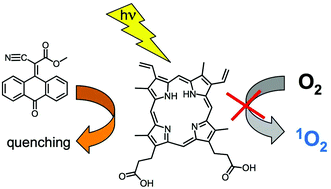Photostabilization of endogenous porphyrins: excited state quenching by fused ring cyanoacrylates†
Abstract
Endogenous chromophores in human skin, when exposed to sunlight, generate harmful reactive oxygen species (ROS). Protoporphyrin IX (PpIX) is one of the common chromophores in human tissue. A series of aromatic cyanoacrylates were tested as quenchers of excited singlet and triplet states of PpIX. While the diaryl cyanoacrylate (1) did not quench excited singlet or triplet states of PpIX, some cyanoacrylates with fused aromatic rings showed excited singlet state quenching rate constants as high as 5 × 109 M−1 s−1 (acetonitrile solution). In addition, one of the fused ring cyanoacrylates (5) quenches PpIX triplet states with a rate constant of 3 × 109 M−1 s−1. The observed quenching rate constants correlated well with the suppression of singlet oxygen generation from PpIX under visible light exposure in the presence of dissolved oxygen. This photostabilization of endogenous chromophores can prevent or reduce ROS generation and perhaps constitute a new approach to mitigating cutaneous oxidative stress.


 Please wait while we load your content...
Please wait while we load your content...